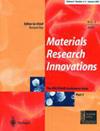Precursor-directed approach to fabricate TiO2-gCN composite: An efficient photocatalyst to harness solar spectrum
Q2 Engineering
引用次数: 2
Abstract
ABSTRACT In this study the porous composites, in-situ TiO2-g-C3N4 (in-situ TiO2-g-CN), was fabricated by in-situ generation of TiO2 from titanium tetra-oximate during thermal polymerisation of urea into gC3N4. For comparison, TiO2-g-C3N4 composite (TiO2-g-CN) and g-C3N4 (gCN) were also prepared by decomposition of urea in the presence and absence of TiO2 nanoparticles (NPs), respectively. The synthesised composites were characterised by FT-IR, SEM-EDX, TGA, and XRD analyses. The analyses of the samples revealed that the particle size of the composites decreases with the addition of TiO2 precursor, titanium tetra-oximate, during g-C3N4 Synthesis. A comparative study has been conducted on the photocatalytic degradation of methylene blue (MB) and methyl orange (MO) dyes in the presence of in-situ TiO2-g-CN, TiO2-g-CN, and gCN under the solar spectrum. In the presence of in-situ TiO2-g-CN, 99.7% degradation of MB and 68.4% degradation of MO was observed within 100 min, and it is superior as compared to TiO2-g-CN and gCN. Graphical Abstract制备TiO2-gCN复合材料的前驱体定向方法:一种利用太阳光谱的高效光催化剂
在本研究中,采用尿素热聚合成gC3N4的方法,由四氧酸钛原位生成TiO2,制备了多孔复合材料原位TiO2-g- c3n4(原位TiO2-g- cn)。为了比较,我们还分别在TiO2纳米粒子(NPs)存在和不存在的情况下,通过尿素分解制备了TiO2-g-C3N4复合材料(TiO2-g- cn)和g-C3N4 (gCN)。通过FT-IR、SEM-EDX、TGA和XRD对合成的复合材料进行了表征。对样品的分析表明,在g-C3N4合成过程中,随着TiO2前驱体四氧酸钛的加入,复合材料的粒径减小。在太阳光谱下对比研究了原位TiO2-g-CN、TiO2-g-CN和gCN存在下,光催化降解亚甲基蓝(MB)和甲基橙(MO)染料的性能。在原位TiO2-g-CN存在的情况下,100 min内对MB的降解率为99.7%,对MO的降解率为68.4%,优于TiO2-g-CN和gCN。图形抽象
本文章由计算机程序翻译,如有差异,请以英文原文为准。
求助全文
约1分钟内获得全文
求助全文
来源期刊

Materials Research Innovations
工程技术-材料科学:综合
CiteScore
5.20
自引率
0.00%
发文量
38
审稿时长
2.8 months
期刊介绍:
Materials Research Innovations covers all areas of materials research with a particular interest in synthesis, processing, and properties from the nanoscale to the microscale to the bulk. Coverage includes all classes of material – ceramics, metals, and polymers; semiconductors and other functional materials; organic and inorganic materials – alone or in combination as composites. Innovation in composition and processing to impart special properties to bulk materials and coatings, and for innovative applications in technology, represents a strong focus. The journal attempts to balance enduring themes of science and engineering with the innovation provided by such areas of research activity.
 求助内容:
求助内容: 应助结果提醒方式:
应助结果提醒方式:


